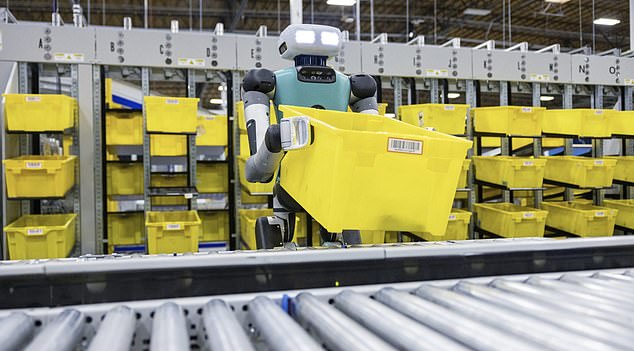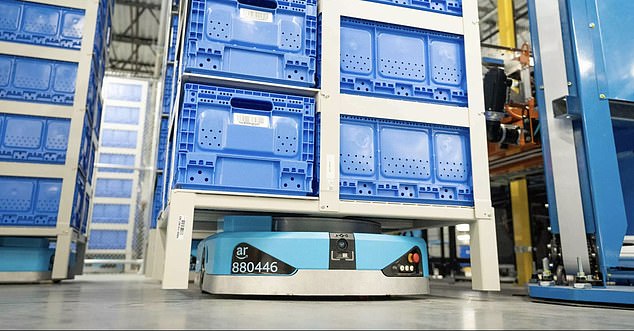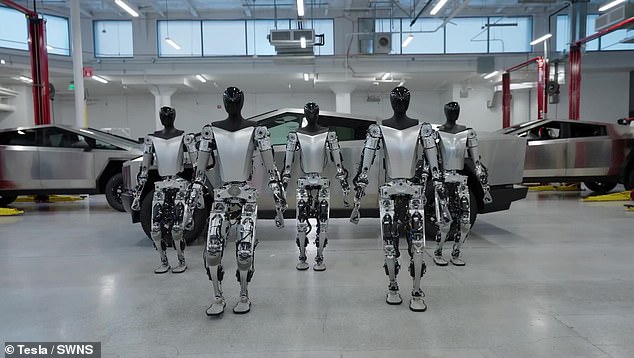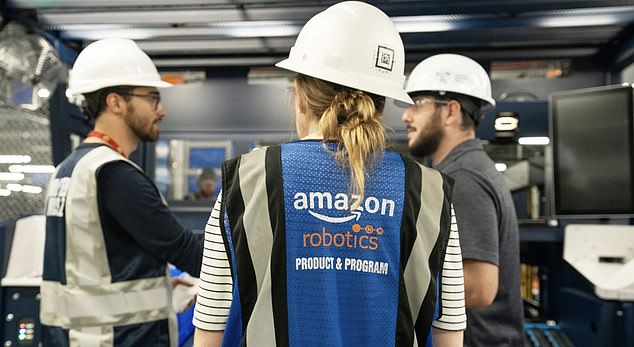Inside Amazon’s ‘dystopian’ new robot warehouses: Fears for company’s 1.5 million human workers as Amazon employs humanoids to do ‘mundane and repetitive’ tasks
>
Retail giant Amazon has announced that humanoid robots that can pick up packages with robotic arms are working alongside human workers at an Amazon warehouse in the US.
The robot, called Digit, is being tested in a warehouse in Texas. It has arms and legs and can grab and handle packages like a human worker.
Amazon now has 750,000 robots working in facilities around the world, but the move to humanoid robots is new, raising concerns about the future of the company’s human workers.
The company denied that it intends to move to “robots-only” warehouses.
The bipedal robot is currently used to move empty boxes in the warehouse: It’s five feet nine inches tall, weighs 140 pounds — and can pick up and carry objects weighing up to 35 pounds.
The move raised concerns about the future of Amazon’s 1.5 million human workers.

The digital robot is five feet and nine inches tall (Amazon)
Testing of Digit, Agility’s bipedal robot, was in its “very early stages,” said Ty Brady, chief technology officer at Amazon Robotics.
“We’re paying a lot of attention to understanding it better and seeing if it’s a good fit for our operations,” said Ty Brady, chief technology officer at Amazon Robotics.
Digit from Agility Robotics can take on many human tasks that are “too repetitive, physically demanding, or dangerous for the humans you work with,” the company says.
It’s one of a wave of humanoid robots from companies ranging from startups to big tech companies including Elon Musk’s Tesla, which is creating a humanoid robot called Optimus.
Musk said he believes robots could one day become more important than company cars.
Goldman Sachs predicted that the humanoid robot market will be worth $150 billion annually worldwide within 15 years – and that humanoid robots will be viable in factories between 2025 and 2028 and in other jobs by 2030 to 2035.

The Sequoia robot system can speed up deliveries by 25%, the company says (Amazon)

Elon Musk’s Optimus robot can also do any human task (Tesla)
Amazon is investing heavily in robotics, having announced a $1 billion “industrial innovation” fund last year.
Other companies like Sanctuary AI believe robots will be able to do any human work within 10 years, and its Phoenix robot has already been shown packing items in stores.
Amazon has claimed that bipedal robots will not “take human jobs”, arguing that the technology can help by “freeing up employees to provide better services to our customers”.
Amazon claims that its robotic systems have created “hundreds of thousands of new jobs” within its operations.
“This includes 700 new job types, in skilled roles, that did not previously exist within the company,” Amazon said.
According to the tech giant, it now has more than 750,000 robots that work “collaboratively” with its human employees, and are often used to take on “highly repetitive tasks.”

Amazon has 750,000 robots working for it (Amazon)
“We believe there is significant opportunity to scale a mobile handling solution, like Digit, that can work collaboratively with employees,” Amazon wrote in a blog post.
“Our initial use for this technology will be to assist employees with bag recycling, which is a highly repetitive process of picking up and transporting empty bags once the inventory has been fully recovered.”
In a separate media event, Ty Brady, chief technology officer at Amazon Robotics, told reporters that he believes human workers cannot be replaced.
He said there is no possibility that Amazon will have fully automated warehouses in the future.
“There’s no part of me that believes this will ever be true,” Brady said.
“People play an essential role in the achievement process; the ability to think at a higher level, the ability to diagnose problems.
At the event, Brady announced the use of a new automated system called Sequoia in one of its Houston warehouses — which can speed up order fulfillment by 25%.
“Collaborative robots include people,” Brady said. “How can people be the stars, the lights, the center of the show, when it comes to the jobs we have to do?
“When we do our job really well, our automated systems kind of blend into the background and become everywhere. You don’t talk too much about the dishwasher in your kitchen.
(Tags for translation)dailymail
